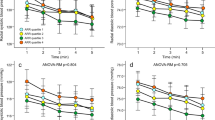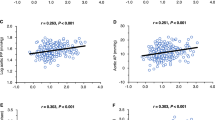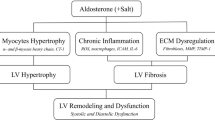Abstract
Excess aldosterone is associated with increased cardiovascular risk. Aldosterone has a permissive effect on vascular fibrosis. Cardiovascular magnetic resonance imaging (CMR) allows study of vascular function by measuring aortic distensibility. We compared aortic distensibility in primary aldosteronism (PA), essential hypertension (EH) and normal controls and explored the relationship between aortic distensibility and pulse wave velocity (PWV). We studied PA (n=14) and EH (n=33) subjects and age-matched healthy controls (n=17) with CMR, including measurement of aortic distensibility, and measured PWV using applanation tonometry. At recruitment, PA and EH patients had similar blood pressure and left ventricular mass. Subjects with PA had significantly lower aortic distensibility and higher PWV compared with EH and healthy controls. These changes were independent of other factors associated with reduced aortic distensibility, including ageing. There was a significant relationship between increasing aortic stiffness and age in keeping with physical and vascular ageing. As expected, aortic distensibility and PWV were closely correlated. These results demonstrate that PA patients display increased arterial stiffness compared with EH, independent of vascular ageing. The implication is that aldosterone invokes functional impairment of arterial function. The long-term implications of arterial stiffening in aldosterone excess require further study.
This is a preview of subscription content, access via your institution
Access options
Subscribe to this journal
Receive 12 digital issues and online access to articles
$119.00 per year
only $9.92 per issue
Buy this article
- Purchase on Springer Link
- Instant access to full article PDF
Prices may be subject to local taxes which are calculated during checkout





Similar content being viewed by others
References
Rossi GP, Bernini G, Caliumi C, Desideri G, Fabris B, Ferri C et al. A prospective study of the prevalence of primary aldosteronism in 1,125 hypertensive patients. J Am Coll Cardiol 2006; 48 (11): 2293–2300.
Calhoun DA, Nishizaka MK, Zaman MA, Thakkar RB, Weissmann P . Hyperaldosteronism among black and white subjects with resistant hypertension. Hypertension 2002; 40 (6): 892–896.
Milliez P, Girerd X, Plouin PF, Blacher J, Safar ME, Mourad JJ . Evidence for an increased rate of cardiovascular events in patients with primary aldosteronism. J Am Coll Cardiol 2005; 45 (8): 1243–1248.
Catena C, Colussi G, Nadalini E, Chiuch A, Baroselli S, Lapenna R et al. Cardiovascular outcomes in patients with primary aldosteronism after treatment. Arch Intern Med 2008; 168 (1): 80–85.
Tomaschitz A, Pilz S, Ritz E, Grammer T, Drechsler C, Boehm BO et al. Association of plasma aldosterone with cardiovascular mortality in patients with low estimated GFR: the Ludwigshafen Risk and Cardiovascular Health (LURIC) Study. Am J Kidney Dis 2011; 57 (3): 403–414.
Rocha R, Stier CT Jr . Pathophysiological effects of aldosterone in cardiovascular tissues. Trends Endocrinol Metab 2001; 12 (7): 308–314.
Connell JM, MacKenzie SM, Freel EM, Fraser R, Davies E . A lifetime of aldosterone excess: long-term consequences of altered regulation of aldosterone production for cardiovascular function. Endocr Rev 2008; 29 (2): 133–154.
Rizzoni D, Paiardi S, Rodella L, Porteri E, De Ciuceis C, Rezzani R et al. Changes in extracellular matrix in subcutaneous small resistance arteries of patients with primary aldosteronism. J Clin Endocrinol Metab 2006; 91 (7): 2638–2642.
Holaj R, Zelinka T, Wichterle D, Petrak O, Strauch B, Widimsky J Jr . Increased intima-media thickness of the common carotid artery in primary aldosteronism in comparison with essential hypertension. J Hypertens 2007; 25 (7): 1451–1457.
McCurley A, Jaffe IZ . Mineralocorticoid receptors in vascular function and disease. Mol Cell Endocrinol 2012; 350 (2): 256–265.
Callera GE, Montezano AC, Yogi A, Tostes RC, He Y, Schiffrin EL et al. c-Src-dependent nongenomic signaling responses to aldosterone are increased in vascular myocytes from spontaneously hypertensive rats. Hypertension 2005; 46 (4): 1032–1038.
Mitchell GF, Parise H, Benjamin EJ, Larson MG, Keyes MJ, Vita JA et al. Changes in arterial stiffness and wave reflection with advancing age in healthy men and women: the Framingham Heart Study. Hypertension 2004; 43 (6): 1239–1245.
van Trijp MJ, Bos WJ, van der Schouw YT, Muller M, Grobbee DE, Bots ML . Non-invasively measured structural and functional arterial characteristics and coronary heart disease risk in middle aged and elderly men. Atherosclerosis 2006; 187 (1): 110–115.
Laurent S, Cockcroft J, Van Bortel L, Boutouyrie P, Giannattasio C, Hayoz D et al. Expert consensus document on arterial stiffness: methodological issues and clinical applications. Eur Heart J 2006; 27 (21): 2588–2605.
Strauch B, Petrak O, Wichterle D, Zelinka T, Holaj R, Widimsky J Jr . Increased arterial wall stiffness in primary aldosteronism in comparison with essential hypertension. Am J Hypertens 2006; 19 (9): 909–914.
Lin YH, Lin LY, Chen A, Wu XM, Lee JK, Su TC et al. Adrenalectomy improves increased carotid intima-media thickness and arterial stiffness in patients with aldosterone producing adenoma. Atherosclerosis 2012; 221 (1): 154–159.
Zimmerli LU, Mark PB, Steedman T, Foster JE, Berg GA, Dargie HJ et al. Vascular function in patients with end-stage renal disease and/or coronary artery disease: a cardiac magnetic resonance imaging study. Kidney Int 2007; 71 (1): 68–73.
Rerkpattanapipat P, Hundley WG, Link KM, Brubaker PH, Hamilton CA, Darty SN et al. Relation of aortic distensibility determined by magnetic resonance imaging in patients >or =60 years of age to systolic heart failure and exercise capacity. Am J Cardiol 2002; 90 (11): 1221–1225.
Funder JW, Carey RM, Fardella C, Gomez-Sanchez CE, Mantero F, Stowasser M et al. Case detection, diagnosis, and treatment of patients with primary aldosteronism: an endocrine society clinical practice guideline. J Clin Endocrinol Metab 2008; 93 (9): 3266–3281.
Rider OJ, Holloway CJ, Emmanuel Y, Bloch E, Clarke K, Neubauer S . Increasing plasma free fatty acids in healthy subjects induces aortic distensibility changes seen in obesity. Circ Cardiovasc Imaging 2012; 5 (3): 367–375.
Mark PB, Doyle A, Blyth KG, Patel RK, Weir RA, Steedman T et al. Vascular function assessed with cardiovascular magnetic resonance predicts survival in patients with advanced chronic kidney disease. J Cardiovasc Magn Reson 2008; 10 (1): 39.
Fink B, Dikalov S, Bassenge E . A new approach for extracellular spin trapping of nitroglycerin-induced superoxide radicals both in vitro and in vivo. Free Radic Biol Med 2000; 28 (1): 121–128.
Delles C, Dymott JA, Neisius U, Rocchiccioli JP, Bryce GJ, Moreno MU et al. Reduced LDL-cholesterol levels in patients with coronary artery disease are paralleled by improved endothelial function: An observational study in patients from 2003 and 2007. Atherosclerosis 2010; 211 (1): 271–277.
Bernini G, Galetta F, Franzoni F, Bardini M, Taurino C, Bernardini M et al. Arterial stiffness, intima-media thickness and carotid artery fibrosis in patients with primary aldosteronism. J Hypertens 2008; 26 (12): 2399–2405.
Strauch B, Petrak O, Zelinka T, Wichterle D, Holaj R, Kasalicky M et al. Adrenalectomy improves arterial stiffness in primary aldosteronism. Am J Hypertens 2008; 21 (10): 1086–1092.
Rogers WJ, Hu YL, Coast D, Vido DA, Kramer CM, Pyeritz RE et al. Age-associated changes in regional aortic pulse wave velocity. J Am Coll Cardiol 2001; 38 (4): 1123–1129.
Rudolph A, Abdel-Aty H, Bohl S, Boye P, Zagrosek A, Dietz R et al. Noninvasive detection of fibrosis applying contrast-enhanced cardiac magnetic resonance in different forms of left ventricular hypertrophy relation to remodeling. J Am Coll Cardiol 2009; 53 (3): 284–291.
Gaddam K, Corros C, Pimenta E, Ahmed M, Denney T, Aban I et al. Rapid reversal of left ventricular hypertrophy and intracardiac volume overload in patients with resistant hypertension and hyperaldosteronism: a prospective clinical study. Hypertension 2010; 55 (5): 1137–1142.
Indra T, Holaj R, Zelinka T, Petrak O, Strauch B, Rosa J et al. Left ventricle remodeling in men with moderate to severe volume-dependent hypertension. J Renin Angiotensin Aldosterone Syst 2012; 13 (4): 426–434.
Stehr CB, Mellado R, Ocaranza MP, Carvajal CA, Mosso L, Becerra E et al. Increased levels of oxidative stress, subclinical inflammation, and myocardial fibrosis markers in primary aldosteronism patients. J Hypertens 2010; 28 (10): 2120–2126.
Robinson MR, Scheuermann-Freestone M, Leeson P, Channon KM, Clarke K, Neubauer S et al. Uncomplicated obesity is associated with abnormal aortic function assessed by cardiovascular magnetic resonance. J Cardiovasc Magn Reson 2008; 10: 10.
Stacey RB, Bertoni AG, Eng J, Bluemke DA, Hundley WG, Herrington D . Modification of the effect of glycemic status on aortic distensibility by age in the multi-ethnic study of atherosclerosis. Hypertension 2010; 55 (1): 26–32.
Rider OJ, Francis JM, Ali MK, Petersen SE, Robinson M, Robson MD et al. Beneficial cardiovascular effects of bariatric surgical and dietary weight loss in obesity. J Am Coll Cardiol 2009; 54 (8): 718–726.
Edwards NC, Steeds RP, Stewart PM, Ferro CJ, Townend JN . Effect of spironolactone on left ventricular mass and aortic stiffness in early-stage chronic kidney disease: a randomized controlled trial. J Am Coll Cardiol 2009; 54 (6): 505–512.
Freel EM, Mark PB, Weir RA, McQuarrie EP, Allan K, Dargie HJ et al. Demonstration of blood pressure-independent noninfarct myocardial fibrosis in primary aldosteronism: a cardiac magnetic resonance imaging study. Circ Cardiovasc Imaging 2012; 5 (6): 740–747.
Acknowledgements
We acknowledge the work of Tracey Steedman and Kirsten Lanaghan in performing cardiac MRI imaging. PBM is funded by Syskid European Union’s FP7, Grant agreement number HEALTH–F2–2009–241544. EMF is funded by a Clinician Scientist Fellowship awarded by the Medical Research Council (reference number G0802803). This study was supported by the European Union’s Seventh Framework Programme ‘EU-MASCARA’ and the British Heart Foundation Programme Grant RG/07/005/23633.
Author information
Authors and Affiliations
Corresponding author
Ethics declarations
Competing interests
The authors declare no conflict of interest.
Additional information
Previous presentation: this work has not been presented or published previously in any form.
Rights and permissions
About this article
Cite this article
Mark, P., Boyle, S., Zimmerli, L. et al. Alterations in vascular function in primary aldosteronism: a cardiovascular magnetic resonance imaging study. J Hum Hypertens 28, 92–97 (2014). https://doi.org/10.1038/jhh.2013.70
Received:
Revised:
Accepted:
Published:
Issue Date:
DOI: https://doi.org/10.1038/jhh.2013.70
Keywords
This article is cited by
-
Comparisons of microvascular and macrovascular changes in aldosteronism-related hypertension and essential hypertension
Scientific Reports (2017)
-
Aldosterone Excess and Resistant Hypertension: Investigation and Treatment
Current Hypertension Reports (2014)



